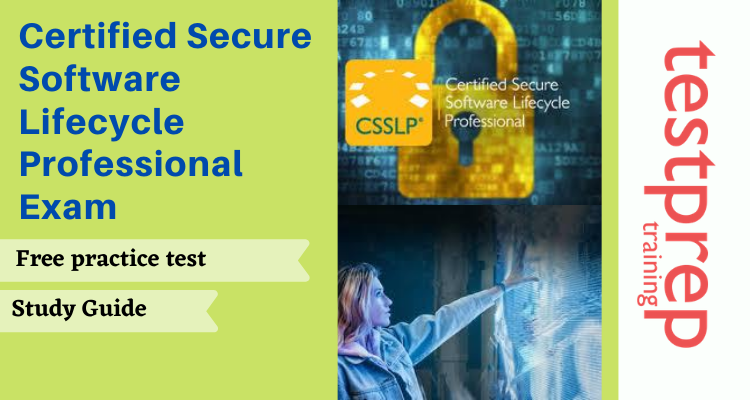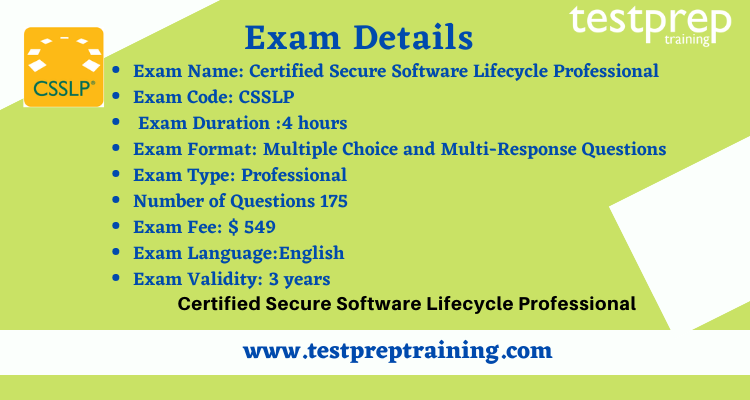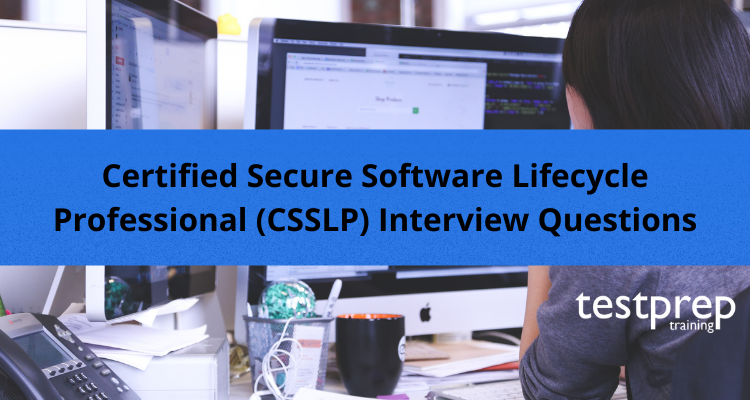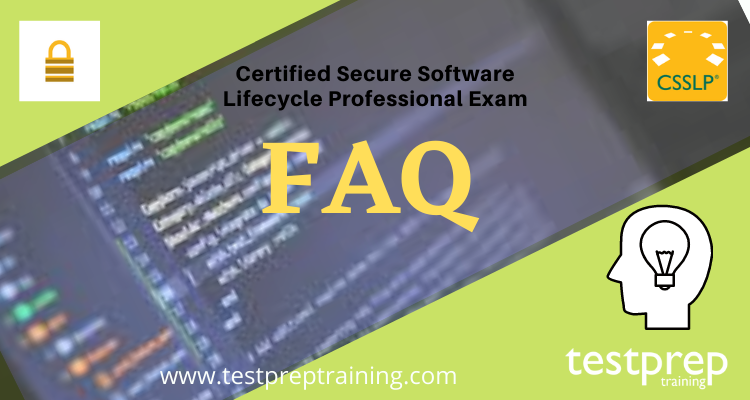CSSLP – Certified Secure Software Lifecycle Professional Exam

Being a Certified Secure Software Lifecycle Professional helps you to build your career and you learn to incorporate security practices. After this certification, you will be able to possess advanced technical skills and knowledge necessary for authentication, authorization, and auditing throughout the SDLC. This certification will help candidates working in the software and security development sectors.
Target Audience
Certified Secure Software Lifecycle Professional examination will be an added advantage to –
- Software Architect, Engineer, and developer
- Application Security Specialist
- Software Program Manager
- Quality Assurance Tester
- Penetration Tester
- Software Procurement Analyst
- Project Manager
- Security Manager
- IT Director/Manager
Exam Prerequisites
The candidate must have a minimum of four years of cumulative paid Software Development Lifecycle (SDLC). Internships and part-time work can also be included in the duration of work experience but you will need documentation on company/organization letterhead confirming your position as an intern. However, the experience must fall within one or more of the eight domains of the (ISC)² CSSLP CBK:
- Domain 1. Secure Software Concepts (10%)
- Domain 2. Secure Software Requirements (14%)
- Domain 3. Secure Software Architecture and Design (14%)
- Domain 4. Secure Software Implementation (14%)
- Domain 5. Secure Software Testing (14%)
- Domain 6. Secure Software Lifecycle Management (11%)
- Domain 7. Secure Software Deployment, Operations, Maintenance (12%)
- Domain 8. Secure Software Supply Chain (11%)
Certified Secure Software Lifecycle Professional Exam Format
While you are preparing for the Certified Secure Software Lifecycle Professional Exam it is very important to have all the exam details at one place. The CSSLP exam costs $549. The number of questions in the examination is 175 and the exam duration is 4 hours. The CSSLP Exam Questions are in a multiple-choice and multiple- Response question examination. The validation of the certification is 3 years.

Exam Registration
- After assessing the prerequisite for the examination, go to the official page of (ISC)² and click on register now.
- The candidate is required to create an account on Pearson VUE and follow the instructions for registration as directed.
- After choosing the date and time of the examination, the candidate can make the payment and complete the registration process.
Exam Policies
Every course and examination has few policies and conditions that the test-taker is advised to adhere to. Below are a few of the important policies to be taken care of before registering for the examination. For more, terms and conditions click on the link.
Certified Secure Software Lifecycle Professional (CSSLP) Interview Questions
Name Matching Policy
Your ID’s first and last names must be identical to the first and last names you used to register with Pearson VUE. If you make a mistake, you have time to amend it before the exam. On the day of the examination, you will not be able to change your name. If the names don’t match, you won’t be able to take the exam, which will result in an increase in your exam price.
Recertification Policy
You may take an exam to recertify if you’ve become decertified due to:
- Not meeting your required number of continuing professional education credits.
- Having the time limit on your endorsement expires.
Rescheduling Policy
You can reschedule your exam only if:
- Online at least 48 hours prior to your exam or
- By phone at least 24 hours before your exam
Pearson VUE charges a reschedule fee of USD $50 and a cancellation fee of USD $100.
For more information about CSSLP examination, click on CSSLP FAQ.
Certified Secure Software Lifecycle Professional CCSSLP Exam Outline
The Course Outline has been recently updated.
We shall now elaborate the course learning resources to prepare for the exam –
Domain 1: Secure Software Concepts
1.1 Core Concepts
- Confidentiality (e.g., encryption)
- Integrity (e.g., hashing, digital signatures, code signing, reliability, modifications, authenticity)
- Availability (e.g., redundancy, replication, clustering, scalability, resiliency)
- Authentication (e.g., multi-factor authentication (MFA), identity & access management (IAM), single sign-on (SSO), federated identity, biometrics)
- Authorization (e.g., access controls, permissions, entitlements)
- Accountability (e.g., auditing, logging)
- Nonrepudiation (e.g., digital signatures, block chain)
- Governance, risk and compliance (GRC) standards (e.g., regulatory authority, legal, industry)
(ISC)2 Reference: CISSP Glossary
1.2 Security Design Principles
- Least privilege (e.g., access control, need-to-know, run-time privileges, Zero Trust)
- Segregation of Duties (SoD) (e.g., multi-party control, secret sharing, split knowledge)
- Defense in depth (e.g., layered controls, geographical diversity, technical diversity, distributed systems)
- Resiliency (e.g., fail safe, fail secure, no single point of failure, failover)
- Economy of mechanism (e.g., single sign-on (SSO), password vaults, resource efficiency)
- Complete mediation (e.g., cookie management, session management, caching of credentials)
- Open design (e.g., Kerckhoffs’s principle, peer review, open source, crowd source)
- Least common mechanism (e.g., compartmentalization/isolation, allow/accept list)
- Psychological acceptability (e.g., password complexity, passwordless authentication, screen layouts, Completely Automated Public Turing test to tell Computers and Humans Apart (CAPTCHA))
- Component reuse (e.g., common controls, libraries)
Domain 2: Secure Software Requirement
2.1 – Manage security within a software development methodology (e.g., Agile, waterfall)
2.2 – Identify and adopt security standards (e.g., implementing security frameworks, promoting security awareness)
2.3 – Outline strategy and roadmap
- Security milestones and checkpoints (e.g., control gate, break/build criteria)
2.4 – Define and develop security documentation
2.5 – Define security metrics (e.g., criticality level, average remediation time, complexity, Key Performance Indicators (KPI), objectives and key results)
2.6 – Decommission applications
- End of Life (EOL) policies (e.g., credential removal, configuration removal, license cancellation, archiving, service-level agreements (SLA))
- Data disposition (e.g., retention, destruction, dependencies)
2.7 – Create security reporting mechanisms (e.g., reports, dashboards, feedback loops)
2.8 – Incorporate integrated risk management methods
- Regulations, standards and guidelines (e.g., International Organization for Standardization (ISO), Payment Card Industry (PCI), National Institute of Standards and Technology (NIST), Open Web Application Security Project (OWASP), Software Assurance Forum for Excellence in Code (SAFECode), Software Assurance Maturity Model (SAMM), Building Security in Maturity Model (BSIMM))
- Legal (e.g., intellectual property, breach notification)
- Risk management (e.g., risk assessment, risk analysis)
- Technical risk vs. business risk
2.9 – Implement secure operation practices
- Change management process
- Incident response plan
- Verification and validation
- Assessment and Authorization (A&A) process
Domain 3: Secure Software Requirements
3.1 – Define software security requirements
- Functional (e.g., business requirements, use cases, stories)
- Non-functional (e.g., security, operational, continuity, deployment)
3.2 – Identify compliance requirements
- Regulatory authority
- Legal
- Industry-specific (e.g., defense, healthcare, commercial, financial, Payment Card Industry (PCI))
- Company-wide (e.g., development tools, standards, frameworks, protocols)
3.3 – Identify data classification requirements
- Data ownership (e.g., data dictionary, data owner, data custodian)
- Data labeling (e.g., sensitivity, impact)
- Data types (e.g., structured, unstructured)
- Data lifecycle (e.g., generation, storage, retention, disposal)
- Data handling (e.g., personally identifiable information (PII), publicly available information)
3.4 – Identify privacy requirements
- Data collection scope
- Data anonymization (e.g., pseudo-anonymous, fully anonymous)
- User rights (legal) and preferences (e.g., data disposal, right to be forgotten, marketing preferences, sharing and using third parties, terms of service)
- Data retention (e.g., how long, where, what)
- Cross-border requirements (e.g., data residency, jurisdiction, multi-national data processing boundaries)
3.5 – Define data access provisioning
- User provisioning
- Service accounts
- Reapproval process
3.6 – Develop misuse and abuse
- Mitigating control identification
3.7 – Develop security requirement traceability matrix
3.8 – Define third-party vendor security requirements
Domain 4: Secure Software Architecture and Design
4.1 – Define the security architecture
- Secure architecture and design patterns (e.g., Sherwood Applied Business Security Architecture (SABSA), security chain of responsibility, federated identity)
- Security controls identification and prioritization
- Distributed computing (e.g., client server, peer-to-peer (P2P), message queuing, N-tier)
- Service-oriented architecture (SOA) (e.g., enterprise service bus, web services, microservices)
- Rich internet applications (e.g., client-side exploits or threats, remote code execution, constant connectivity)
- Pervasive/ubiquitous computing (e.g., Internet of Things (IoT), wireless, location-based, Radio-Frequency Identification (RFID), Near Field Communication (NFC), sensor networks, mesh)
- Embedded software (e.g., secure boot, secure memory, secure update)
- Cloud architectures (e.g., Software as a Service (SaaS), Platform as a Service (PaaS), Infrastructure as a Service (IaaS))
- Mobile applications (e.g., implicit data collection privacy)
- Hardware platform concerns (e.g., side-channel mitigation, speculative execution mitigation, secure element, firmware, drivers)
- Cognitive computing (e.g., artificial intelligence (AI), virtual reality, augmented reality)
- Industrial Internet of Things (IoT) (e.g., facility-related, automotive, robotics, medical devices, software-defined production processes)
4.2 – Perform secure interface design
- Security management interfaces, out-of-band management, log interfaces
- Upstream/downstream dependencies (e.g., key and data sharing between apps)
- Protocol design choices (e.g., application programming interfaces (API), weaknesses, state, models)
4.3 – Evaluate and select reusable technologies
- Credential management (e.g., X.509, single sign-on (SSO))
- Flow control (e.g., proxies, firewalls, protocols, queuing)
- Data loss prevention (DLP)
- Virtualization (e.g., Infrastructure as code (IaC), hypervisor, containers)
- Trusted computing (e.g., Trusted Platform Module (TPM), Trusted Computing Base (TCB))
- Database security (e.g., encryption, triggers, views, privilege management, secure connections)
- Programming language environment (e.g., common language runtime, Java virtual machine (VM), Python, PowerShell)
- Operating system (OS) controls and services
- Secure backup and restoration planning
- Secure data retention, retrieval, and destruction
4.4 – Perform threat modeling
- Threat modeling methodologies (e.g., Spoofing, Tampering, Repudiation, Information Disclosure, Denial of Service, and Elevation of Privilege (STRIDE), Process for Attack Simulation and Threat Analysis (PASTA), Hybrid Threat Modeling Method, Common Vulnerability Scoring System (CVSS))
- Common threats (e.g., advanced persistent threat (APT), insider threat, common malware, third-party suppliers)
- Attack surface evaluation
- Threat analysis
- Threat intelligence (e.g., identify credible relevant threats, predict)
4.5 – Perform architectural risk assessment and design reviews
4.6 – Model (non-functional) security properties and constraints
4.7 – Define secure operational architecture (e.g., deployment topology, operational interfaces, Continuous Integration and Continuous Delivery (CI/CD))
Domain 5: Secure Software Implementation
5.1 – Adhere to relevant secure coding practices (e.g., standards, guidelines, regulations)
- Declarative versus imperative (programmatic) security
- Concurrency (e.g., thread safety, database concurrency controls)
- Input validation and sanitization
- Error and exception handling
- Output sanitization (e.g., encoding, obfuscation)
- Secure logging & auditing (e.g., confidentiality, privacy)
- Session management
- Trusted/untrusted application programming interfaces (API), and libraries
- Resource management (e.g., compute, storage, network, memory management)
- Secure configuration management (e.g., baseline security configuration, credentials management)
- Tokenization
- Isolation (e.g., sandboxing, virtualization, containerization, Separation Kernel Protection Profiles)
- Cryptography (e.g., payload, field level, transport, storage, agility, encryption, algorithm selection)
- Access control (e.g., trust zones, function permissions, role-based access control (RBAC), discretionary access control (DAC), mandatory access control (MAC))
- Processor microarchitecture security extensions
5.2 – Analyze code for security risks
- Secure code reuse
- Vulnerability databases/lists (e.g., Open Web Application Security Project (OWASP) Top 10, Common Weakness Enumerations (CWE), SANS Top 25 Most Dangerous Software Errors)
- Static application security testing (SAST) (e.g., automated code coverage, linting)
- Manual code review (e.g., peer review)
- Inspect for malicious code (e.g., backdoors, logic bombs, high entropy)
5.3 – Implement security controls (e.g., watchdogs, file integrity monitoring, anti-malware)
5.4 – Address the identified security risks (e.g., risk strategy)
5.5 – Evaluate and integrate components
- Systems-of-systems integration (e.g., trust contracts, security testing, analysis)
- Reusing third-party code or open-source libraries in a secure manner (e.g., software composition analysis)
5.6 – Apply security during the build process
- Anti-tampering techniques (e.g., code signing, obfuscation)
- Compiler switches
- Address compiler warnings
Domain 6: Secure Software Testing
6.1 – Develop security testing strategy & plan
- Standards (e.g., International Organization for Standardization (ISO), Open Source Security Testing Methodology Manual, Software Engineering Institute)
- Functional security testing (e.g., logic)
- Nonfunctional security testing (e.g., reliability, performance, scalability)
- Testing techniques (e.g., known environment testing, unknown environment testing, functional testing, acceptance testing)
- Testing environment (e.g., interoperability, test harness)
- Security researcher outreach (e.g., bug bounties)
6.2 – Develop security test cases
- Attack surface validation
- Automated vulnerability testing (e.g., dynamic application security testing (DAST), interactive application security testing (IAST))
- Penetration tests (e.g., security controls, known vulnerabilities, known malware)
- Fuzzing (e.g., generated, mutated)
- Simulation (e.g., simulating production environment and production data, synthetic transactions)
- Failure (e.g., fault injection, stress testing, break testing))
- Cryptographic validation (e.g., pseudorandom number generators, entropy)
- Unit testing and code coverage
- Regression tests
- Integration tests
- Continuous testing
- Misuse and abuse test cases
6.3 – Verify and validate documentation (e.g., installation and setup instructions, error messages, user guides, release notes)
6.4 – Identify undocumented functionality
6.5 – Analyze security implications of test results (e.g., impact on product management, prioritization, break/build criteria)
6.6 – Classify and track security errors
- Bug tracking (e.g., defects, errors and vulnerabilities)
- Risk scoring (e.g., Common Vulnerability Scoring System (CVSS))
6.7 – Secure test data
- Generate test data (e.g., referential integrity, statistical quality, production representative)
- Reuse of production data (e.g., obfuscation, sanitization, anonymization, tokenization, data aggregation mitigation)
6.8 – Perform verification and validation testing (e.g., independent/internal verification and validation, acceptance test)
Domain 7: Secure Software Deployment, Operations, Maintenance
7.1 – Perform operational risk analysis
- Deployment environment (e.g., staging, production, quality assurance (QA))
- Personnel training (e.g., administrators vs. users)
- Legal compliance (e.g., adherence to guidelines, regulations, privacy laws, copyright, etc.)
- System integration
7.2 – Secure configuration and version control
- Hardware
- Baseline configuration
- Version control/patching
- Documentation practices
7.3 – Release software securely
- Secure Continuous Integration and Continuous Delivery (CI/CD) pipeline (e.g., DevSecOps)
- Application security toolchain
- Build artifact verification (e.g., code signing, hashes)
7.4 – Store and manage security data
- Credentials
- Secrets
- Keys/certificates
- Configurations
7.5 – Ensure secure installation
- Secure boot (e.g., key generation, access, management)
- Least privilege
- Environment hardening (e.g., configuration hardening, secure patch/updates, firewall)
- Secure provisioning (e.g., credentials, configuration, licensing, Infrastructure as code (IaC))
- Security policy implementation
7.6 – Obtain security approval to operate (e.g., risk acceptance, sign-off at appropriate level)
7.7 – Perform information security continuous monitoring
- Observable data (e.g., logs, events, telemetry, trace data, metrics)
- Threat intelligence
- Intrusion detection/response
- Regulation and privacy changes
- Integration analysis (e.g., security information and event management (SIEM))
7.8 – Execute the incident response plan
- Incident triage
- Forensics
- Remediation
- Root cause analysis
7.9 – Perform patch management (e.g. secure release, testing)
7.10 – Perform vulnerability management (e.g., tracking, triaging, Common Vulnerabilities and Exposures (CVE))
7.11 – Incorporate runtime protection (e.g., Runtime Application Self Protection (RASP), web application firewall (WAF), Address Space Layout Randomization (ASLR), dynamic execution prevention)
7.12 – Support continuity of operations
- Backup, archiving, retention
- Disaster recovery plan (DRP)
- Resiliency (e.g., operational redundancy, erasure code, survivability, denial-of-service (DoS))
- Business continuity plan (BCP)
7.13 – Integrate service level objectives and service-level agreements (SLA) (e.g., maintenance, performance, availability, qualified personnel)
Domain 8: Secure Software Supply Chain
8.1 – Implement software supply chain risk management (e.g., International Organization for Standardization (ISO), National Institute of Standards and Technology (NIST))
- Identification and selection of the components
- Risk assessment of the components (e.g., mitigate, accept)
- Maintaining third-party components list (e.g., software bill of materials)
- Monitoring for changes and vulnerabilities
8.2 – Analyze security of third-party software
- Certifications
- Assessment reports (e.g., cloud controls matrix)
- Origin and support
8.3 – Verify pedigree and provenance
- Secure transfer (e.g., chain of custody, authenticity, integrity)
- System sharing/interconnections
- Code repository security
- Build environment security
- Cryptographically-hashed, digitally-signed components
- Right to audit
8.4 – Ensure and verify supplier security requirements in the acquisition process
- Audit of security policy compliance (e.g., secure software development practices)
- Vulnerability/incident notification, response, coordination, and reporting
- Maintenance and support structure (e.g., community versus commercial, licensing)
- Security track record
- Scope of testing (e.g., shared responsibility model)
- Log integration into security information and event management (SIEM)
8.5 – Support contractual requirements (e.g., intellectual property ownership, code escrow, liability, warranty, End-User License Agreement (EULA), service-level agreements (SLA))
Preparatory Guide for Certified Secure Software Lifecycle Professional Exam
Following study guide will help you ace you exam and enhance your CSSLP Exam Preparations:

CISSP Ultimate Guide
The CISSP Ultimate Guide is your one-stop destination to all the doubts related to the CISSP exam. There is nothing wrong to say that the CSSLP Exam Guide serves as complete coverage of the CISSP exam and its related domains. Candidates who want a full study of knowledge should visit and bookmark this guide so they may access it from anywhere and at any time.
Self-placed Training
(ISC)² Online Self-Paced Training is a viable alternative to traditional classroom training. Candidates may learn at their own pace with interactive study materials in these sophisticated and unique training courses. Remember that after you’ve paid for the course, you’ll have access to the materials for 120 days.
CISPP Flashcards
Candidates preparing for the CISSP exam can now study anytime and anywhere for the certification exam. CISSP Flashcards provided by (ISC)² helps candidates get immediate feedback relating to their queries. Individual cards can also be flagged for further study using these flashcards. To make learning easier and more efficient, the cards are divided into sections for each subject.
Instructor-led Training
(ISC)² offers instructor-led training as an option to help candidates prepare for the exam. These online training events enable you to join from the comfort of your own computer, saving you time and money on the trip.
Join Study groups
Joining study groups is an excellent method to become totally immersed in the certification test for which you applied. These groups will assist you in keeping up to know with any recent modifications or exam updates. In addition, both novices and professionals are represented in these clubs. You are free to ask any test-related question or discuss the exam without the fear of being judged.
Evaluate yourself with CSSLP Practice Exam
During the training session, practice exams are essential. When a candidate has finished one topic or area, the easiest approach to evaluate oneself is to take practice exams. This will not only help students recall stuff, but it will also help them identify their weak spots. Test your abilities with test prep training to increase your preparation and chances of passing the exam. Start using CSSLP Mock Tests right away!



